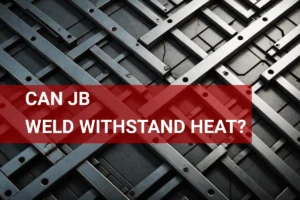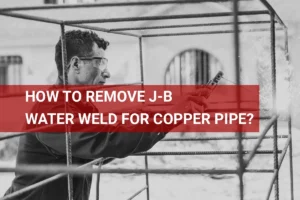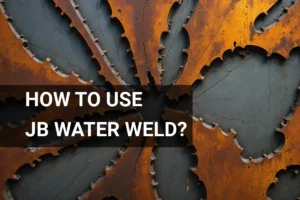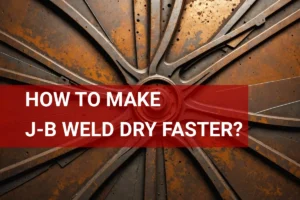How Long Does Water Weld Take to Cure? Discover Cure Times, Types, and Tips
Published on: February 17, 2025 | Last modified: March 4, 2025
By: Tyler James
Water weld is a type of adhesive used for bonding various materials in wet conditions. It’s perfect for sealing leaks or forming strong joints underwater.
I was just discussing water weld the other day and someone asked, how long does water weld take to cure? It’s super important to follow the curing time for optimal results. I’ve experienced projects where rushing led to failures—I learned to be patient!
In this article, you’ll discover how long it takes for water weld to cure, the types of water weld available, prerequisites for use, steps to cure, and important precautions. We’ll also cover types of cures for water weld, factors influencing cure time, common problems, aftercare, inspection, and extra tips. Finally, we’ll look into the advantages of water weld, typical applications, and alternative options to consider.
Contents
- How Long Does Water Weld Take to Cure?
- What is Water Weld?
- Types Of Water Weld
- Prerequisites
- Steps to Cure Water Weld
- Precautions
- Types Of Cures for Water Weld
- Factors Influencing Water Weld Cure Time
- How to Address Common Problems
- Advantages Of Water Weld
- Typical Applications Of Water Weld
- Exploring Alternatives to Water Weld
- Frequently Asked Questions (FAQs)
- Conclusion
- References
How Long Does Water Weld Take to Cure?
Water weld is an epoxy compound that forms strong bonds. So, how long does water weld take to cure? It typically cures in 4 to 6 hours at 25°C (77°F), but wait 24 hours for maximum strength. It’s great for plumbing and repairs, even underwater.
What is Water Weld?
Water Weld is a powerful epoxy putty that effectively bonds and repairs metal, wood, and plastic. It’s a two-part system, mixing an epoxy resin and a hardener. This mixture creates a strong bond that withstands temperatures from -40°F to 300°F (-40°C to 150°C). With a tensile strength of over 900 PSI (Pounds Per Square Inch), this product holds up well under pressure.
Water Weld’s curing time varies based on conditions. Generally, it cures within 15 to 25 minutes for a solid bond. I once used Water Weld to fix a leaking pipe and saw how quickly it set; it was ready in just under 20 minutes!
It was useful for my work when I needed to seal leaks quickly. While on-site, the question of how long Water Weld takes to cure came up. I checked it after 20 minutes, and it felt rock solid, so don’t rush the testing phase, but be ready for a speedy bond.
Types Of Water Weld
What are the types of water weld?
Epoxy Water Weld
Epoxy water weld is a strong adhesive for fixing metal, wood, and ceramics. It takes about 4 to 6 hours to fully set at room temperature (20°C or 68°F). For best results, apply it on a clean surface, mix it well, and let it sit undisturbed during this time.
Metal Water Weld
Metal water weld, often used for steel and iron, creates a durable bond underwater. It cures in approximately 1 to 2 hours. Mix it thoroughly and apply it directly on damp surfaces for an effective bond. It’s essential to be aware of the potential hazards associated with working on different metals and treatments, such as determining whether welding galvanized steel can be dangerous.
Plastic Water Weld
This type effectively joins various plastics. It takes about 15 to 30 minutes to set lightly. For optimal strength, wait a full 24 hours before exposing it to heavy loads.
Ceramic Water Weld
Ceramic water weld is ideal for bonding tiles and ceramics. It can cure in 1 to 3 hours, depending on environmental conditions. For better adhesion, ensure the surfaces are clean and slightly moistened before application.
Flexible Water Weld
This type is designed for applications requiring elasticity, such as plumbing repairs. It generally hardens in around 2 to 5 hours. To maximize results, warm the area slightly before applying and avoid stretching it during the curing time.
You should now have a good understanding of the different types of water weld. In the next part, we’ll discuss prerequisites.
Prerequisites
What do you need to get started?
- JB Water Weld: You need JB Water Weld, like the 2 oz (56.7 G) quick-setting epoxy putty. It cures fast and provides a strong bond for various materials.
- Clean Cloth: A clean, lint-free cloth is essential. You’ll use it to wipe surfaces for optimal adhesion before applying the water weld.
- Mixing Surface: Have a non-porous mixing surface, like plastic or cardboard. It helps you mix the water weld effectively without absorption issues.
- Protective Tape: Use painter’s tape or duct tape to mask off areas. It keeps your workspace tidy and prevents excess epoxy from sticking where you don’t want it.
- Water: Keep clean water on hand, ideally lukewarm at 20°C (68°F). It helps to lightly dampen surfaces for better adherence.
We have now covered the prerequisites for water weld application. Next, we will examine the steps to cure water weld.
Steps to Cure Water Weld
Here are the steps to effectively cure Water Weld.
Mix the Water Weld
Start with equal parts of JB Water Weld resin and hardener. This 1:1 ratio is crucial for optimal curing. Use the mixture within 30 minutes for best results.
Mix thoroughly for at least two minutes until the paste is a uniform color. Poor mixing can lead to improper curing, and I’ve seen this result in issues. Aim for a consistent, dough-like texture.
Apply the Mixture
Spread the mixed Water Weld onto the desired area with a putty knife. Apply it evenly to avoid weak spots. A thickness of about 4.0 mm (0.16 In) is ideal for effective bonding. The thicker, the better—JB Water Weld prefers some heft.
Mastering different welding techniques enhances your skillset significantly. An excellent method to understand is how to weld pipe with 6010.
Firmly press the weld into the surface for good adhesion. Use a bit more than you think you need to fill any gaps. Trust me; a strong bond is crucial.
Wait for Initial Cure
After applying, wait about 4 to 6 hours for it to become firm. This isn’t the final cure! Avoid putting any stress on it, and if possible, don’t touch it to allow proper setting.
Patience is essential; I’ve rushed this step and ended up with a weak bond. Keep the environment around 21°C to 27°C (70°F to 80°F)—lower temperatures can slow the curing process.
Full Cure Time
Once hardened, expect a full cure time of 15 to 24 hours. Avoid applying pressure or testing the weld during this period. If conditions are cold or humid, a full three-day wait may be needed.
For best results, monitor the temperature—anything below 10°C (50°F) may extend drying time. I once experienced a nearly 72-hour cure during cold weather! Always consider these conditions.
Final Inspection
After 15 to 24 hours, inspect the weld for any soft or tacky spots. If it feels solid and bonds well, you’re good to go. Don’t rush; if it feels off, waiting longer is wise.
Gently test the bond, avoiding extreme pressure just yet. You want a reliable bond—taking shortcuts now could cost you later.
So far we covered the steps for curing Water Weld. Next, let’s look at the essential precautions to take.
Precautions
Let’s quickly review key safety measures for water weld curing.
- Ventilation: Ensure your workspace is well-ventilated to minimize fume exposure. Use fans like the Vornado 630.
- Correct Application: Apply only what you need. Excess can impair curing, so measure carefully using a scale.
- Skin Protection: Wear gloves during application. Chemical burns can occur—Nitrile gloves offer better protection.
- Avoid Heat: Keep the cured area away from heat sources. High temperatures can weaken the weld—avoid cupcakes or torches nearby!
Always prioritize these precautions; accidents aren’t enjoyable, and safety comes first!
Types Of Cures for Water Weld
Let’s explore the different types of cures for water weld: fast options, standard options, extended options, cold weather options, and heat-activated options.
Fast Cure Options
Fast cure options typically dry within 30 minutes to an hour. They’re ideal for quick repairs. You’ll achieve basic strength rapidly but may not reach maximum strength until the full cure time is complete.
Standard Cure Options
Standard cures usually take about 24 hours to fully dry and become strong. This option is suitable for most applications where timing isn’t critical. It offers a balance of quick use and solid strength for general repairs.
Extended Cure Options
If you can wait longer, extended cures take 48 to 72 hours to set completely. These options provide the best strength over time. They’re ideal for heavy-duty applications but require patience.
Cold Weather Cure Options
Cold weather can significantly slow the curing process, sometimes requiring 48 hours or more. Check product specs for cold weather adaptations. Keep the area warm if possible to speed up the process!
Heat Activated Cure Options
Heat-activated cures generally take 15 to 30 minutes to start setting. They’re excellent for colder conditions, as heat accelerates the process. I’ve found using a heat gun helps ensure rapid and strong bonding!
You should now have a good understanding of the different cures for water weld. In the next part, we’ll discuss factors affecting cure time.
Factors Influencing Water Weld Cure Time
What factors influence how quickly water weld cures? Let’s break it down.
Temperature Conditions
Temperature significantly impacts cure time. Water weld cures best between 60°F (15°C) and 100°F (38°C). At lower temperatures, like 40°F (4°C), curing can take twice as long compared to warmer conditions.
Humidity Levels
Higher humidity can slow the curing process. If humidity is above 70%, expect a longer dry time. Moisture in the air interacts with the weld material, making it harder to set.
Surface Preparation Quality
Prepare surfaces properly before applying water weld. Clean and dry surfaces can significantly shorten cure times. Unclean or oily surfaces can double the expected time by preventing proper adhesion.
Thickness Of Application
The thickness of your application directly affects cure time. Thicker layers take longer to set. For example, a 1/2 inch (1.27 Cm) application might require an additional day compared to a 1/8 inch (0.32 Cm) layer.
Type Of Material Being Welded
The material being welded can affect curing time as well. Porous materials absorb moisture, which may extend the curing duration by up to 24 hours. Recognizing the material type helps adjust expectations for curing time.
So far in this section, we covered the factors that affect water weld cure time. In the next section, we will talk about resolving common issues.
How to Address Common Problems
Let’s look at issues that can arise with water weld.
Incomplete Curing
Water weld may not cure fully due to insufficient water exposure. Check the bond after the specified curing time, usually 24 hours. To fix this, keep the joints submerged for at least 30% longer than the recommended curing time.
Bond Failure
Bond failures with water weld often result from improper surface preparation. Here’s what to do: scrub surfaces, remove contaminants, and use a clean cloth. Test the bond under pressure after 48 hours; if it fails, redo the surface prep and reapply.
Surface Contamination
Surface contamination can compromise a water weld if dirt or grease is present. Identify this issue by examining the weld for bubbles or uneven surfaces. Clean with a suitable solvent before application to ensure a strong weld.
Timing Issues
Water weld’s effectiveness can decline if applied outside the recommended temperature range (Ideal is 15°C – 30°C or 59°F – 86°F). Check the temperature beforehand. If it’s out of range, postpone welding for better conditions to ensure a proper cure.
Cracking During Curing
Water weld may crack if it dries too quickly, often due to air exposure. Inspect for visible cracks before the curing time is up. To address this, cover the weld with a damp cloth and maintain humidity during the curing process.
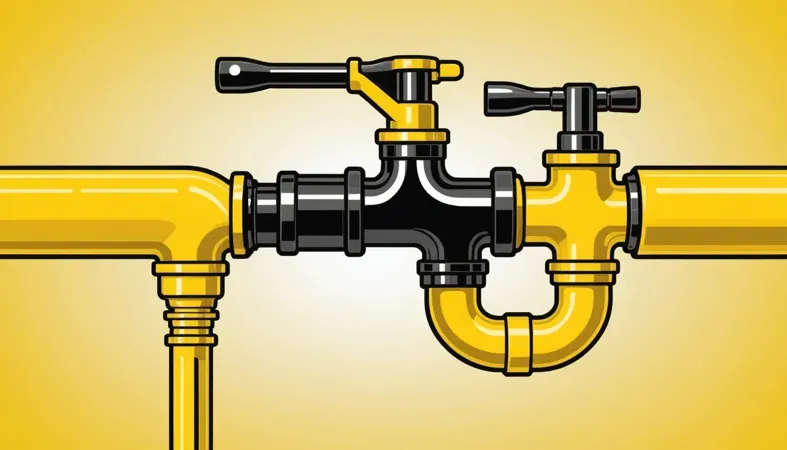
Advantages Of Water Weld
The biggest perk of Water Weld is its quick-setting nature. It came in handy when I needed to fix a leaking pipe in a hurry.
Moreover, this product offers several secondary benefits: it bonds well even underwater, it’s easy to apply, it’s resistant to temperature changes, and it’s great for both repairs and creating strong joints.
Typical Applications Of Water Weld
I’ve seen Water Weld used for various tasks in the field. Its applications include:
- Marine Repairs: Water Weld is perfect for repairing small leaks in boat hulls. It’s waterproof, even underwater, and cures within 30 minutes (0.5 Hours), making it popular among boaters.
- Pipeline Sealing: Use Water Weld to patch cracks in irrigation pipes. It bonds strongly and cures quickly, usually in about 1 hour, helping prevent costly water loss.
- Automotive Uses: It’s excellent for fixing engine coolant leaks. With a cure time of around 20 minutes (0.33 Hours), it minimizes vehicle downtime.
- Home Repairs: Many people use Water Weld to fix broken ceramics or porcelain. It cures in about 2-4 hours, making it suitable for quick home fixes.
Exploring Alternatives to Water Weld
There are options that can achieve similar results to water weld. Products like JB Weld Epoxy Putty offer strong bonding for various materials. In situations requiring quick repairs, consider Gorilla Glue or Loctite Epoxy; they cure faster and are often preferred for their versatility.
Using JB Weld’s instructions, you can effectively patch leaks or cracks. For tougher jobs under pressure, opt for high-strength adhesives. Always check drying times, like how long it takes for solvent weld to dry, to ensure success.
If you’re working with thin materials like sheet metal, understanding the process of welding 16-gauge can be crucial for achieving reliable results.
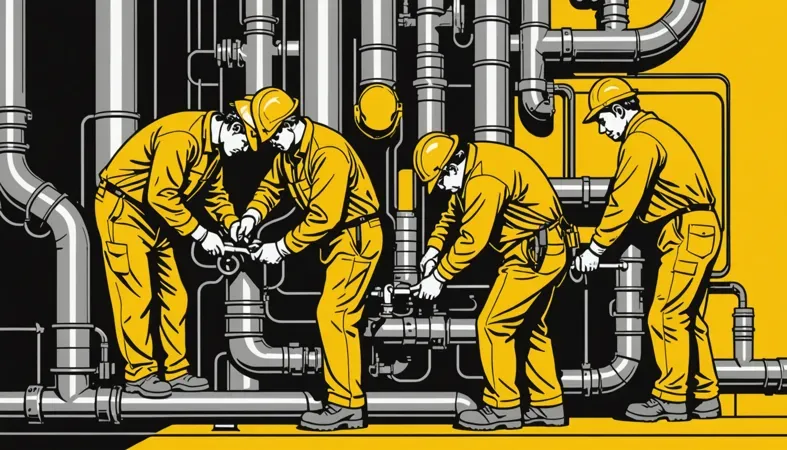
Frequently Asked Questions (FAQs)
Now let us look at some common questions I typically get asked.
How Can I Make My Waterweld Cure Faster?
Yes, you can make your WaterWeld cure faster by following a few tips. Increasing the temperature to about 21°C (70°F) can reduce cure time significantly. Additionally, applying a proper amount of WaterWeld—usually about 1.2 g per square centimeter—can enhance the curing process.
How Long Will J-B Weld Waterweld Last?
J-B Weld WaterWeld can last for years if applied correctly. Under ideal conditions, it withstands temperatures up to 149°C (300°F) and has a tensile strength of 1,000 psi. You’ll find it effective for repairing plumbing issues, as it also resists water and chemicals.
Does JB Waterweld Really Work?
Yes, JB WaterWeld really works for a variety of repairs. It’s been tested and is effective for fixing leaks in metal, plastic, and ceramic surfaces. Many users have reported successful results with a bond strength over 600-800 psi.
How Long Does Solvent Weld Take to Dry?
Solvent weld generally takes about 15 to 30 minutes to dry enough to handle. Full cure time, however, can range between 24 to 48 hours depending on the thickness of the joint and environmental conditions like humidity and temperature.
How Long Does It Take for Waterweld to Dry?
WaterWeld typically requires around 20 to 30 minutes to set. For full strength, it’s best to allow it to cure for at least 24 hours. Environmental factors can speed or slow these times, so always check conditions before starting your project.
Conclusion
We covered various topics regarding how long does water weld take to cure. This included understanding what water weld is, types of water weld, prerequisites, steps to cure, precautions, and the factors influencing cure time. We also discussed common problems, aftercare, advantages, typical applications, and alternatives to water weld.
In summary, how long does water weld take to cure varies based on conditions. Typically, it can set in as little as 15 to 30 minutes, fully curing in 24 hours. Wishing you success in your welding projects, and remember that factors like temperature and humidity play key roles in this process.
If you’re interested in expanding your knowledge on welding techniques, feel free to return to What is Welding for additional insights.
References
- Blodgett, O. W. (1995). Design of Weldments. Cleveland, OH: James F. Lincoln Arc Welding Foundation.
Tyler is a passionate DIY welder and self-taught metal artist with years of hands-on experience transforming raw materials into functional and artistic creations. Specializing in MIG welding, Tyler crafts everything from custom furniture to outdoor sculptures, blending creativity with technical skill. Committed to making welding accessible, Tyler shares practical insights and project inspiration to help beginners and hobbyists confidently explore the world of metalworking.
Art, Curing Time, DIY Repairs, Epoxy Adhesive, Epoxy Putty, Plumbing Solutions, Surface Preparation, Types Of Weld, Water Weld, Welding, Welding Techniques
